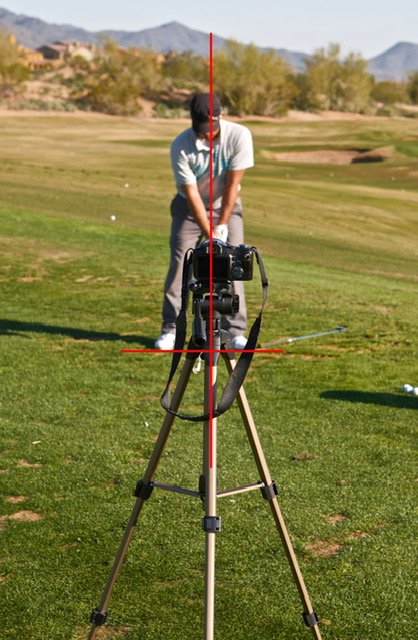Camera Angles
Down-the-Line
This angle is a little challenging to set up consistently. The camera should be setup roughly hip or belly button height. The camera should be aimed parallel to the target line, as illustrated by the three red lines in the picture. The player should be in the left center of the frame with a little room over the players head and feet.
By far, this is the best position for shooting Down the Line video is along the toe line - the left-most red line where the green is the brightest. The camera angle pointed parallel to the target line and halfway between the ball and toes is acceptable but not ideal. Lastly, a camera positioned directly behind the ball (the right most red line) - regardless of how perfectly parallel it may be to the target line in not not very helpful at all as it will distort items (such as position of the club shaft at various stages of the swing).
The down the line view is illustrative of a golfer’s set-up, posture, Foveal vision, neck tilts, 3-D motion of the spine, lateral flexion (side-bend), knees, extending and flexing or changing flex,s swing plane, spine extension, inclination to the ground, swing path, Closure rate (ROC), the determination of early extension, among other items.
Face on (Caddie View)
The Face-on or “Caddie View” video should be shot with the camera angle at around hip or belly button height, positioned right in the middle of the player’s stance, square / perpendicular to the player’s target line. The player should be centered in the frame with enough room above the player’s head to see the hands and at least a bit of the shart at the top of the backswing and enough room below the player’s feet to see the ball.
Key areas of what the face on or “Caddie View” is trying to capture is ball position, foot flare, grip, stance width, lateral flexion (side bend), 3d Motion of the spine, inclination to the ground, turning in a circle, excessive sway (lateral right movement) or slide (lateral left movement), what type of posting is performed in the swing (front, center or rear), head movement, neck-tilts, lever creation / retention, backswing length, weight distribution at key locations in the swing, low point control, early releasing of the club (casting), stalling of the body (flipping the handle).
Why are these angles so important? In order for me to determine the actual cause of your swing flaw, I need comprehensive information. With video shot from the Face-on and Down-the-Line views will provide me with the snapshots of your swing that I can slow down, enlarge and point out to you the player, the correct assessment of the swing issue and the appropriate swing correction program.


